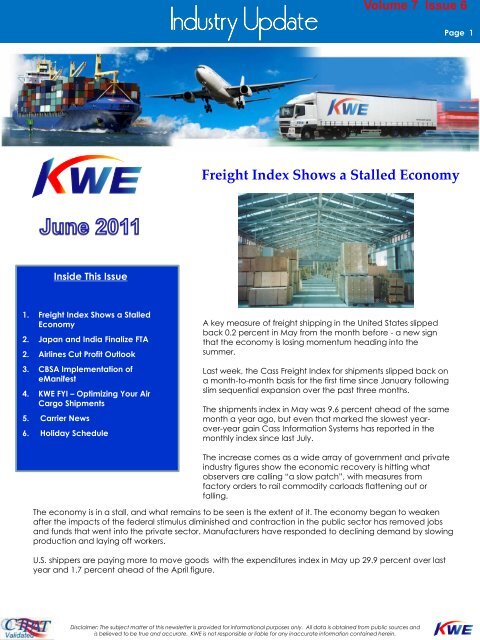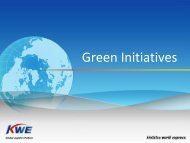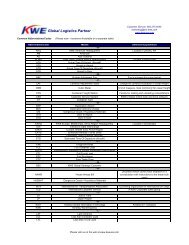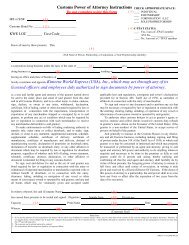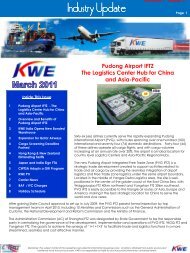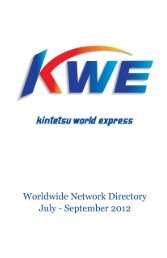2011 June - KWE Industry Update - Kintetsu World Express (USA), Inc.
2011 June - KWE Industry Update - Kintetsu World Express (USA), Inc.
2011 June - KWE Industry Update - Kintetsu World Express (USA), Inc.
Create successful ePaper yourself
Turn your PDF publications into a flip-book with our unique Google optimized e-Paper software.
<strong>Industry</strong> <strong>Update</strong><br />
Page<br />
Volume 7 Issue 6<br />
1<br />
Freight Index Shows a Stalled Economy<br />
Inside This Issue<br />
1. Freight Index Shows a Stalled<br />
Economy<br />
2. Japan and India Finalize FTA<br />
2. Airlines Cut Profit Outlook<br />
3. CBSA Implementation of<br />
eManifest<br />
4. <strong>KWE</strong> FYI – Optimizing Your Air<br />
Cargo Shipments<br />
5. Carrier News<br />
6. Holiday Schedule<br />
A key measure of freight shipping in the United States slipped<br />
back 0.2 percent in May from the month before - a new sign<br />
that the economy is losing momentum heading into the<br />
summer.<br />
Last week, the Cass Freight Index for shipments slipped back on<br />
a month-to-month basis for the first time since January following<br />
slim sequential expansion over the past three months.<br />
The shipments index in May was 9.6 percent ahead of the same<br />
month a year ago, but even that marked the slowest yearover-year<br />
gain Cass Information Systems has reported in the<br />
monthly index since last July.<br />
The increase comes as a wide array of government and private<br />
industry figures show the economic recovery is hitting what<br />
observers are calling ―a slow patch‖, with measures from<br />
factory orders to rail commodity carloads flattening out or<br />
falling.<br />
The economy is in a stall, and what remains to be seen is the extent of it. The economy began to weaken<br />
after the impacts of the federal stimulus diminished and contraction in the public sector has removed jobs<br />
and funds that went into the private sector. Manufacturers have responded to declining demand by slowing<br />
production and laying off workers.<br />
U.S. shippers are paying more to move goods with the expenditures index in May up 29.9 percent over last<br />
year and 1.7 percent ahead of the April figure.<br />
Disclaimer: The subject matter of this newsletter is provided for informational purposes only. All data is obtained from public sources and<br />
is believed to be true and accurate. <strong>KWE</strong> is not responsible or liable for any inaccurate information contained herein.
2010 Profit $18 Billion<br />
Orig <strong>2011</strong><br />
Projection<br />
$8.4 Billion<br />
Rvsd<br />
<strong>2011</strong><br />
$4b<br />
Page 2<br />
Japan and India Finalize FTA<br />
On Aug 1, Japan and India will put a free trade agreement in<br />
place ushering in a new era of trade between the two giant<br />
economies by eliminating about 94 percent of import tariffs on<br />
most products moving between the countries.<br />
Japanese Foreign Minister, Takeaki Matsumoto and his Indian<br />
counterpart, Somanahali Mallaiah Krishna came to an<br />
agreement during talks held in Budapest while attending a twoday<br />
meeting of foreign ministers from the 46 member nations of<br />
the Asia-Europe Meeting. The Japan-India FTA, formally called<br />
the Comprehensive Economic Partnership Agreement between<br />
Japan and the Republic of India (IJCEPA) was signed in mid-<br />
February after about four years of negotiations. However, the<br />
two countries had not agreed on a specific date for putting the<br />
trade pact into effect until now.<br />
Japan and India are Asia’s second- and third-largest economies after China. After 42 years, Japan lost it’s status<br />
as the world’s second-biggest economy (after the United States), to China last year.<br />
The Japan-India FTA will eliminate import tariffs on about 94 percent of trade by value within 10 years. According<br />
to Japanese government figures, Japan exported $9.9 billion worth of products to India and imported $6.2 billion<br />
worth of goods from the South Asian country in 2010.<br />
The FTA will be Japan’s 12th such trade pact.<br />
Airlines Cut Profit Outlook<br />
The International Air Transport Association scaled back<br />
its <strong>2011</strong> industry profit forecast by more than half to $4<br />
billion from an estimated $8.4 billion the industry group<br />
had projected just three months ago.<br />
―Natural disasters in Japan, unrest in the Middle East<br />
and North Africa, plus the sharp rise in oil prices have<br />
slashed industry profit expectations,‖ said Giovanni<br />
Bisignani, IATA’s outgoing director general.<br />
The $4 billion collective profit forecast for <strong>2011</strong><br />
compares with an estimated $18 billion profit booked<br />
by IATA’s 238 member airlines in 2010.<br />
IATA cut its <strong>2011</strong> growth forecast for cargo to 5.5 percent from 6.1 percent, but upped its yield growth forecast to 4<br />
percent from 1.9 percent, noting that robust economic conditions have allowed carriers to partially recover higher<br />
fuel prices.<br />
The projected <strong>2011</strong> profit margin is expected to shrink to 0.7 percent on forecast revenue of $598 billion, compared<br />
with last year’s 3.2 percent on revenues of $562 billion.<br />
IATA singled out higher fuel prices as the key reason for its lower profit forecast. It is estimating an average oil price<br />
of $110 per barrel for North Sea Brent, a 15 percent increase on its previous forecast of $96 per barrel.<br />
Disclaimer: The subject matter of this newsletter is provided for informational purposes only. All data is obtained from public sources and is<br />
believed to be true and accurate. <strong>KWE</strong> is not responsible or liable for any inaccurate information contained herein.
Page 3<br />
CBSA Implementation for eManifest<br />
The Canada Border Services Agency (CBSA) recognizes that it will take time for the trade community to adjust<br />
to the new reporting requirements. Thus, eManifest will be implemented over a number of years, by client<br />
type, using an 18-month implementation timeline.<br />
What is eManifest?<br />
• 0-12 months - Once all eManifest transmission options (Electronic<br />
Data Interchange (EDI) and eManifest Portal) become publicly<br />
available, there will be a 12-month period for clients to incorporate<br />
eManifest requirements into their business processes.<br />
• 12-18 months - After the initial year, the eManifest regulations will<br />
take effect. However the CBSA will offer a six-month period of<br />
informed compliance.<br />
eManifest is a Government of Canada<br />
initiative to enhance the ability of the<br />
Canada Border Services Agency<br />
(CBSA) to identify potential threats to<br />
Canada while facilitating the movement<br />
of low-risk shipments across the<br />
border.<br />
The eManifest initiative is the third<br />
phase of the Advance Commercial<br />
Information (ACI) program. ACI phases<br />
1 and 2 require air and marine carriers<br />
to submit pre-arrival cargo and<br />
conveyance information electronically,<br />
within advance time frames.<br />
• 18 months and beyond - The implementation timeline is complete.<br />
Clients may be subject to administrative monetary penalties (AMPs)<br />
for non-compliance.<br />
Implementation by Client Type<br />
When fully implemented, eManifest will<br />
require trade partners in all modes of<br />
transportation (air, marine, highway and<br />
rail) to submit cargo, crew/passenger,<br />
conveyance, secondary and importer<br />
data to the CBSA prior to arrival at the<br />
border.<br />
Highway carriers<br />
Starting October 31, 2010, current EDI options for data transmission included functionality for the transmission<br />
of highway carriers' cargo and conveyance data. To facilitate compliance and ease the transition from<br />
paper reporting to pre-arrival electronic data transmission for small- to medium-sized enterprises, the CBSA<br />
will offer an eManifest Portal option beginning in early summer <strong>2011</strong>. Although registered and tested EDI<br />
clients could have begun transmitting eManifest information on October 31, 2010, the 18-month<br />
implementation timeline for all highway carriers to transmit cargo and conveyance data will begin in early<br />
summer <strong>2011</strong>.<br />
Rail carriers<br />
In late <strong>2011</strong> / early 2012, the 18-month implementation timeline will begin for rail carriers to transmit cargo<br />
and conveyance data.<br />
Freight forwarders<br />
In 2012, the 18-month implementation timeline will begin for freight forwarders in all modes of transportation<br />
to transmit secondary cargo / house bill data.<br />
Importers<br />
In 2012, the 18-month implementation timeline will begin for importers in the marine mode to begin<br />
transmission of advance trade data (formerly called Importer Admissibility Data or IAD).<br />
The CBSA encourages clients to adopt eManifest requirements early within each implementation timeline.<br />
Being an early adopter will allow businesses to benefit from more time to fine-tune business processes and<br />
correct problems before requirements become mandatory and regulations come into force.<br />
Note: The implementation dates for importer data in other modes and crew/passenger data in all modes will<br />
be confirmed at a later date.<br />
Disclaimer: The subject matter of this newsletter is provided for informational purposes only. All data is obtained from public sources and is<br />
believed to be true and accurate. <strong>KWE</strong> is not responsible or liable for any inaccurate information contained herein.
Page 4<br />
<strong>KWE</strong> FYI<br />
<strong>KWE</strong> FYI is a section within our <strong>Industry</strong> <strong>Update</strong> featuring items and<br />
trends of interest relevant to transportation and logistics, global trade<br />
and future developments that may have impact in these areas<br />
.<br />
Optimizing Your Air Cargo Shipments<br />
Surging oil and kerosene prices, increased security measures and government focus on<br />
compliance are all factors currently affecting the air cargo industry.<br />
It’s now more important than ever to make sure that YOU, the shipper, are optimizing your<br />
supply chain.<br />
Here are some tips and advice on how you can do this:<br />
Partner with Your Transportation Providers<br />
‣ Limit the number of providers you work with – identifying a few trusted partners will<br />
create operational efficiencies and optimize rates<br />
Utilize the Right Service Levels<br />
‣ Shipments often have different weight and size characteristics and transit time<br />
requirements. Select the right service level option for each of these needs – it can be<br />
an easy way to reduce costs<br />
Double Check Your Documentation<br />
‣ Missing or incomplete commercial invoice information is a common cause of customs<br />
holds for air cargo shipments – easily avoid these delays by making accurate and<br />
complete shipping documentation a priority<br />
Broker Through Your Carrier<br />
‣ Coordinating broker services through your carrier can minimize hand-offs and ensure a<br />
smooth and timely clearance and delivery.<br />
Insist on Visibility<br />
‣ Having complete end-to-end tracking visibility of your shipments is critical. Visibility<br />
enables you to identify problems and keep your shipments on track avoiding potential<br />
negative impacts on time and cost.<br />
Maximize Your Pallet<br />
‣ Package and consolidate goods to maximize pallet space. While weight is a factor,<br />
space is also key and efficient packing will reduce your chance of incurring<br />
dimensional weight fees<br />
Weigh Your Costs<br />
‣ If speed and reliability are critical to your business, don’t use price as your only carrier<br />
criteria. The repercussions of a missed deadline or upset customer can end up costing<br />
you more in the long run.<br />
Please contact your local <strong>KWE</strong> office to find out information on how we can help you<br />
optimize your supply chain!<br />
Disclaimer: The subject matter of this newsletter is provided for informational purposes only. All data is obtained from public sources and<br />
is believed to be true and accurate. <strong>KWE</strong> is not responsible or liable for any inaccurate information contained herein.
Carrier News<br />
JAL and AA Strengthen Relationship<br />
Japan Airlines and American Airlines have enhanced their cargo<br />
relationship, routing freight through five key cities in the U.S. and<br />
three Japanese cities.<br />
Page 5<br />
Honolulu is now a key hub for the transfer of cargo between the<br />
Americas and Asia. In addition to Honolulu, the new key transfer<br />
points in the U.S. are Los Angeles, Chicago, Dallas/Fort Worth and<br />
New York. In Japan, the carriers will route freight through Tokyo,<br />
Osaka and Nagoya.<br />
According to a Japan Airlines press release, "the tighter cargo<br />
relationship is expected to enable both airlines to provide their<br />
respective customers with additional value, while maximizing the<br />
utilization of cargo capacity . In addition, new synergies between<br />
the carriers’ express products will now provide seamless transfer of<br />
express shipments between the airlines.―<br />
A joint business agreement between the two carriers began in April.<br />
Lufthansa Cargo Opens Pharma Hub in India<br />
Lufthansa Cargo inaugurated its South Asia pharmaceutical hub at India’s Hyderabad airport with shipments of<br />
medicines to Philadelphia and Chicago.<br />
The Md-11 freighter flight followed Lufthansa Cargo’s certification of the airport as meeting the complex requirements<br />
for transporting temperature-sensitive pharmaceuticals – the first station in its global network to be awarded this status.<br />
Lufthansa will operate three MD-11 freighter flights a week to Hyderabad, which has the capacity to handle 30,000<br />
tons a year of pharmaceutical products.<br />
―Parallel to the certification process, we are further expanding our own fleet of cold-chain containers in Hyderabad,‖<br />
said Christopher Dehio, Senior Manager Global Key Accounts Temperature Control at Lufthansa Cargo.<br />
Previously, textiles dominated Lufthansa export shipments from India, but pharmaceuticals, auto parts and electronic<br />
goods now account for half of the traffic. Thus, Lufthansa Cargo and GMR Group, operator of Hyderabad airport,<br />
unveiled plans in December to jointly develop the airport into the key hub in South Asia for the transport of<br />
temperature-sensitive pharmaceuticals.<br />
Asiana Airlines Comes to Oregon, <strong>USA</strong><br />
Asiana Airlines will launch nonstop all-cargo service between <strong>Inc</strong>heon and Portland International Airports beginning<br />
Sept. 2. The thrice-weekly service will use a Boeing 747 freighter and will return to PDX through Anchorage, Miami or<br />
Atlanta. Officials expect to transport seasonal perishables such as Oregon blueberries, cherries, Dungeness crab and<br />
oysters on the route.<br />
During a press conference announcing the new service, Oregon Governor John Kitzhaber said the Asiana flights will<br />
help generate about 80 more local jobs and $27 million a year in local business activity. The state's top three trading<br />
partners are Japan, Korea and China — locations that are all served by the new flights.<br />
"For Portland businesses, nonstop air cargo service to Asia is absolutely critical in getting our goods to market," Portland<br />
Mayor Sam Adams said in a statement. ―This is an important accomplishment for the Port of Portland and will translate<br />
into more trade and job creation for our region."<br />
Disclaimer: The subject matter of this newsletter is provided for informational purposes only. All data is obtained from public sources and<br />
is believed to be true and accurate. <strong>KWE</strong> is not responsible or liable for any inaccurate information contained herein.
Page 6<br />
<strong>Update</strong>: Bunker Adjustment Factor (BAF) and Inland Fuel Charge (IFC)<br />
WESTBOUND (from <strong>USA</strong> to Asian destinations)<br />
July 01 through Sept 30, <strong>2011</strong><br />
20’ dry 40’-45’ dry 20’ reefer other reefer<br />
BAF – West Coast 596 745 839 1049<br />
BAF – East Coast 1178 1472 1566 1957<br />
IFC – Pure truck 108 108 108 108<br />
IFC – Truck/Rail 375 375 375 375<br />
EASTBOUND (from Asian origins to <strong>USA</strong>)<br />
July 01 through Sept 30, <strong>2011</strong><br />
per 20’ per 40’ per 40HQ per 45’<br />
BAF – West Coast 454 568 639 719<br />
BAF – East Coast 886 1107 1245 1401<br />
IFC-Truck 108 108 108 108<br />
IFC-RIPI 188 188 188 188<br />
IFC-IPI 375 375 375 375<br />
<strong>June</strong> Holiday Schedule<br />
12 Independence Day – Philippines Skeleton Staff<br />
20 Birth Anniversary of Dr. Jose Rizal – Philippines Skeleton Staff<br />
24 St. Jean Baptiste Day - Canada All offices closed<br />
Disclaimer: The subject matter of this newsletter is provided for informational purposes only. All data is obtained from public sources<br />
and is believed to be true and accurate. <strong>KWE</strong> is not responsible or liable for any inaccurate information contained herein.


